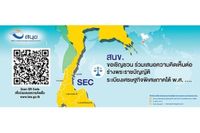The Office of Transport and Traffic Policy and Planning (สนข.) has announced significant strides in developing the southern economic corridor project, often referred to as the land bridge initiative. This ambitious endeavor, valued at an impressive 1 trillion baht, aims to streamline transportation links between the Gulf of Thailand and the Andaman Sea, thereby boosting economic growth and enhancing regional connectivity.
In alignment with the Thai government's vision, the Office has crafted a draft bill for the Special Economic Corridor (SEC). This initiative is part of a wider scheme to elevate the infrastructure within the region. In order to ensure that the legislation genuinely reflects public interest, สนข. is actively soliciting feedback from stakeholders. The public consultation period began on March 21, 2025, and will continue until April 20, 2025, providing 31 days for comprehensive input.
This engagement is in accordance with Section 77 of the Constitution of the Kingdom of Thailand, which mandates public consultations for legislative processes. Interested parties can submit their comments through various online platforms, including the central legal system website and the websites of the Ministry of Transport and สนข.
The primary focus of this legislative initiative is to set the groundwork for the land bridge project, which aims to enhance the efficiency of the transport system in southern Thailand, aligning with a larger strategy to bolster economic activities. The proposed infrastructure will facilitate smoother transit and logistics operations, thereby attracting investments and stimulating job creation in the area.
According to reports, if the regulatory framework is approved by the House of Representatives, the SEC is projected to be operational by September 2025. Following this timeline, there will be plans to establish an SEC office that will spearhead various operations related to the project.
In the context of the project's execution, the Request for Proposal (RFP) for private sector involvement is expected to launch within the first quarter of 2026, specifically between January and April. Thereafter, the selection process for investors will take place in the second quarter of 2026, from May to August. Such a structured approach is essential for maintaining transparency and encouraging competitive bids from qualified firms.
Furthermore, following the invocations of private sector interest, a draft contract will be presented to the Cabinet for approval during the same July to September 2026 timeframe. The goal at that point will be to finalize agreements promptly to ensure the commencement of construction in the third quarter of 2026. It is estimated that construction for phase one of the land bridge project will conclude, and services will commence by the end of 2028.
To facilitate the overall environmental concerns, the environmental impact assessments (EIA) are anticipated to be completed in conjunction with the design phase of the project, ensuring that sustainable practices are incorporated into the construction process. The expected timelines for these reviews and approvals are expected to align with those set by the Office of Natural Resources and Environmental Policy and Planning (สผ.), further underscoring the government's commitment to environmental stewardship.
As the project progresses, the integration of the highway and rail systems will be critical to its success, aiming at not only improving traffic flow but also reducing transportation costs for goods and services traversing southern Thailand. The Office believes that the economic corridor will serve as a strategic advantage in positioning Thailand as a logistics hub in Southeast Asia.
The land bridge project represents a transformative opportunity for the economic landscape in southern Thailand. It not only addresses immediate infrastructural needs but also lays the foundation for long-term socio-economic benefits. Looking ahead, it will be crucial for various stakeholders, from citizens to investors, to engage actively in the consultation phases to ensure the final outcomes align with both public needs and environmental standards.
In summary, the southern economic corridor project is not just a plan; it's an ambition to connect, develop, and thrive. The coming months will be crucial as engagement ramps up, and the timeline lays the groundwork for one of the most significant developments in Thailand's transport history.





